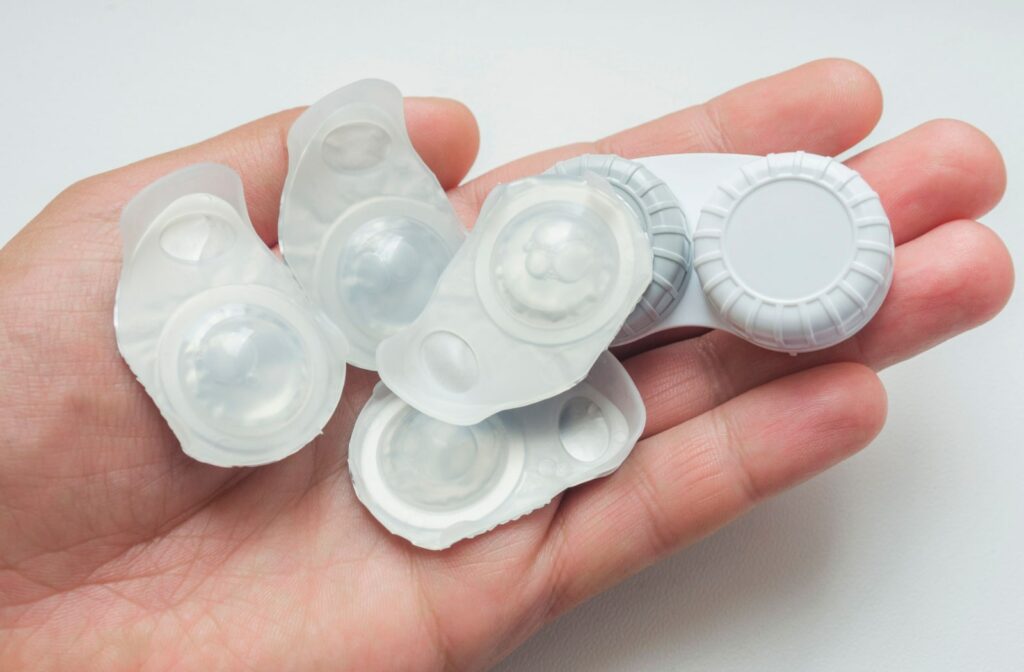If you have decided to get contacts instead of glasses, your optometrist may ask if you prefer daily (single use) or monthly (multiple use) contact lenses.
Daily vs. monthly refers to their replacement schedule. Daily contacts are designed to be worn for a single day and then discarded. These lenses are only to be worn once and replaced with a fresh pair the following day. And monthly contacts are designed to be worn multiple times, up to a month, before being replaced.
The style you choose depends on your lifestyle, preferences, comfort of the contacts and eye health. If you’re considering contacts, ensuring your eyes are in good health with a thorough eye exam, fitting, and follow-up appointments with your optometrist is important.
Monthly Contact Lenses
Wearing monthly contacts requires a bit of work and attention. You’ll need to keep them clean and store them properly, stick to a replacement schedule, and ensure you keep up with regular check-ups. You should also follow your optometrist’s or optician’s instructions for how many hours a day you should wear your monthly contacts.
Monthly Contact Care
Monthlies are generally made up of a more durable, thicker, but still soft and flexible, material than daily contacts so they can last longer and remain comfortable for extended wear.
Wearing them for too long during the day can cause eye irritation and dry eyes. It’s important to follow the recommended wearing schedule and avoid wearing them beyond the recommended hours.
Monthly contacts require regular cleaning and maintenance. They should be removed at the end of the day and cleaned using a contact lens solution to remove protein, calcium, lipids, and other debris that can accumulate on the lenses. The substances found naturally in your tears can build up on your lenses, reducing their comfort and making your eyes more prone to infection.
After cleaning, monthly contacts should be disinfected using contact lens solution and stored in a clean and appropriate contact lens case. This cleaning regimen helps to maintain the hygiene of the lenses and prevent the growth of bacteria. It is generally not recommended to sleep with monthly contacts in your eyes. Keeping the lenses in overnight increases the risk of compromising the cornea and introducing bacteria to your eyes, leading to eye infections. Always follow the guidance of your eye care professional regarding the proper wearing schedule for your specific lenses.
Monthly Contact Costs
Generally, monthly contacts initially cost less than daily contacts. However, if you lose them, dry them out, or tear them, the cost of replacing them may eventually outweigh the cost of daily contacts. Additionally, you will also have to buy contact lens cases, cleaning solutions, and time to clean and maintain them.
Daily Contact Lenses
Single use contacts are worn once and then disposed of before you go to bed. There is no need to clean, disinfect, or store them, meaning there is less risk of eye infections or complications.
They are made with thinner material and, although they tend to be more comfortable, degrade faster than monthlies. And even though it may be tempting to wear them for more than one day, it is strongly ill-advised. They are not designed for prolonged use.
Daily Contact Care
You don’t have to worry about upkeep regarding daily wear contacts. When you wake up, clean your hands before inserting your contacts, and you’re all good. You may have to clean the lenses if you accidentally dropped them on the sink or counter, but that requires just a bit of contact solution.
Remember to store your supply of contacts in a dark place out of the reach of children and pets. And remember that because they are thinner than monthly contacts, they may tear if you are too rough while handling them. So, always have a pair of glasses on hand, just in case.
At the end of the day, all you need to know is how far it is to the garbage so you can toss them into it at night. However, don’t throw them in the toilet because they can negatively impact the environment. The fact that you have to go through 365 days of contacts and the waste from the packaging does make single use lenses a less popular choice for some. Some offices will have a recycling bin used to collect and recycle contact lenses and packaging.
Daily Contact Costs
Daily disposable contacts are more expensive than monthly contacts. You’ll usually find them in packs of 30 for around $30. Larger packs of 90 can be found for upward of $80. Most contact lens manufacturers have rebates when patients order a year supply of contacts which significantly help off-set the cost difference.
Though they may cost more than monthly contacts, daily contacts are better for your eye health and more convenient.
Find the Perfect Contact Lenses at Perry & Morgan Eye Care
Neither is better; they’re just different. Which style works best for you depends on your preference and eye health. While trends show the number of patients wearing single use lens is on the rise, you may not have had the opportunity to be fit with a daily disposable contact.
The great thing is that your eye care team can often provide a sample so you can test them out in the real world. Try both options and analyze your experience to decide whether monthly or daily contact lenses would be a better fit for your habits. By doing so, you can assess how well you handle the responsibilities associated with monthly lenses or if you prefer the convenience of daily lenses.
Book an appointment with us at Perry Eye Care & Morgan Eye Care. We’ll help you find the perfect contacts for you.



